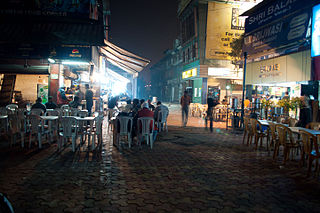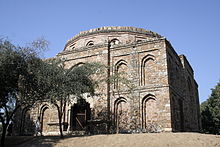
Nehru Place is a large commercial centre in Delhi, India. Although its importance as a financial centre has declined in recent years, Nehru Place is still a prominent commercial area in South Delhi and houses the headquarters of several Indian firms and rivals with other financial centres in the metropolis like Connaught Place, Bhikaji Cama Place and Rajendra Place.
The Mudrika Seva is one of the most popular bus routes in Delhi, India. It was started by the Delhi Transport Corporation (DTC) in May 1974, and is now operated by both the Corporation and DIMTS' cluster buses. The service runs on Delhi's inner ring road, with major stops at AIIMS, Lajpat Nagar, Sarai Kale Khan, ITO, Delhi Gate, Kashmere Gate, DU North Campus, Model Town, Azadpur market, Shalimar Bagh, Punjabi Bagh, Britannia Factory, Rajouri Garden, Naraina, and DU South Campus.

Vasant Kunj is one of the most posh neighbourhoods of Delhi NCR located in South West Delhi district, Delhi, India. The area is home to several businessmen, actors, cricketers as well as politicians like the former prime minister of India, Dr Manmohan Singh, but also well-known members of the international ESD ExpertNet. The locality is also very close to Indira Gandhi International Airport and the commercial hub of Gurgaon. In the early '90s, Vasant Kunj was the agriculture-based land of Kishangarh Village.
Ber Sarai is a small neighbourhood located between Jawaharlal Nehru University (JNU) and IIT Delhi in the South West district of Delhi, India.
Ramakrishna Puram popularly known as R.K. Puram, is a residential colony in Delhi. Named after the saint Sri Ramakrishna, it houses many high-profile corporate houses.

The Inner Ring Road refers to one of the two main ring roads, the main inner one and an outer one in Delhi, India. The two ring roads have a combined length of 87 km (54 mi). There are two less significant Ring Roads in Delhi apart from the above two, namely the Rural Ring Road, that runs across the rural areas on the fringe of North West Delhi and West Delhi Ring Road, limited only to the West Delhi region.

New Friends Colony is a posh residential colony of South East Delhi, India. It consists of A, B, C, D Blocks. It is situated near Uttar Pradesh border.
The Delhi Tamil Education Association Senior Secondary Schools are eight secondary schools located in Delhi, India.
Dwarka is a neighbourhood located in Southwestern edge of Indian Capital New Delhi in South West Delhi & West Delhi districts of the NCT of Delhi. The district court that functions under the Delhi High Court for South West Delhi is located in Dwarka.

Delhi Ridge, sometimes simply called The Ridge, is a ridge in the Northern Aravalli leopard wildlife corridor in the National Capital Territory of Delhi in India. It is a northern extension of the ancient Aravalli Range, some 1.5 billion years old. The ridge consists of quartzite rocks and extends from the southeast at Tughlaqabad, near the Bhatti mines, branching out in places and tapering off in the north near Wazirabad on the west bank of the river Yamuna, covering about 35 kilometres.

South Delhi is an administrative district of the National Capital Territory of Delhi in India with its headquarters in Saket. Administratively, the district is divided into three subdivisions, Saket, Hauz Khas, and Mehrauli. It is bounded by the Yamuna River to the east, the districts of New Delhi to the north, Faridabad District of Haryana state to the southeast, Gurgaon District of Haryana to the southwest, and South West Delhi to the west.
Delhi Public School, Vasant Kunj is a school located in Vasant Kunj, New Delhi, India. DPS Vasant Kunj offers academic services from Kindergarten through Grade XII. The school has a combined strength of 205 teachers at the senior and junior level, and an enrollment of four thousand students.
Sarita Vihar is a posh residential colony situated in South East Delhi,National Capital Territory of Delhi ,India. It is near the Kalindi Kunj- Noida Toll bridge or GD Birla Marg-Road 13A which connects the district to Noida.The area is situated close to Uttar pradesh border. It is believed that the site was primarily chosen as the construction site for the Games Village of the 1982 Asian Games, however on the insistence of the late Prime Minister Rajiv Gandhi, the plan was changed to convert it into an upscale residential housing locality. In 2013, it was awarded the "Greenest Colony in Delhi" tag by the then Chief Minister of Delhi, Ms. Sheila Dikshit, credited to the efforts of its RWA members who have aggressively worked towards improving the state of parks and green spots in the locality.

The Hauz Khas metro station is an interchange station between the Yellow Line and the Magenta Line of the Delhi Metro. It serves Hauz Khas Enclave, Sarvapriya Vihar, Vijay Mandal Enclave, RBI colony, Mayfair Gardens and the IIT Delhi. The entrance to the station is located on Outer Ring Road, to the east of Aurobindo Marg and to the west of Khelgaon Marg.
Jangpura is a neighbourhood in South East Delhi district of Delhi. Beginning from the east and moving clockwise, it is bordered by the Mathura Road, Ring Railway line, Silver Oak Park beyond the Defence Colony Flyover, and the Barapulla Nullah. It encompasses the residential areas of Jangpura A and B on either side of the Mathura Road, Jangpura (Bhogal) extending west from the Mathura Road until Jangpura Extension, which in turn extends along the northern side of the Ring Railway line to the east side of the Defence Colony Flyover on Josip Broz Tito Marg. The small colony of Pant Nagar along the Barapulla Nullah is contiguous with Jangpura Extension.

Kishangarh is an Urban village. The Village is located near Vasant Kunj in South West Delhi district of Delhi, India, on the hills of Aravali, between Mehrauli and Vasant Kunj. One extreme of Kishangarh is around 4 km from Qutub Minar in historic Mehrauli area. The other extreme is approximately 7.5 km from the Indira Gandhi International Airport. Munirka is about 5 km, where the Aruna Asaf Ali Marg, connecting the main Vasant Kunj Marg with the Outer Ring Road forms its western boundary.
JJ Colony is a resettlement colony on the Gram Sabha Land of Madanpur Khadar Village in the south-eastern region of Delhi. It is located in close proximity to Sarita Vihar and Kalindi Kunj, about 1 kilometers from the Uttar Pradesh border. It was created in 2004 when the slum dwellers from across Delhi were forcefully evicted and relocated to the urban peripheries. Since its formation, the community has undergone massive structural, political, economic, and social changes affecting the lives of the community. The transformation of JJ Colony in Khadar is underscored by several challenges ranging from the provision of basic amenities, mobility, and the condition of women's safety. From then to now JJ colony in khadar has changed much from the lanes of agriculture canal to road channels has come far bit.

Madanpur Khadar is an urban village in South East district of Delhi. It is located on Delhi-UP Border and is an 800 years old village, named after Thakur Madan Singh Chauhan. The term Khadar is attached to the village’s name because it is situated on the banks of Yamuna river. It was declared as an urban village by the administrative authorities under Delhi Metropolitan Council in 1966.











